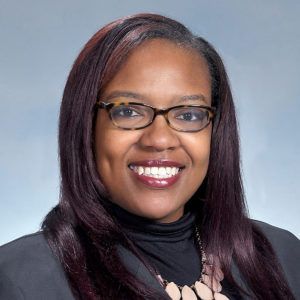SHEENA SOLOMON
The Gifford Foundation
Executive Director
Syracuse, New York
PLACES Advisory Board
 Sheena Solomon had to defy expectations when she gave birth to her son just a few days after her 16th birthday.
Sheena Solomon had to defy expectations when she gave birth to her son just a few days after her 16th birthday.
“Everyone made an assumption that I would fail,” she said.
Solomon said all of the stereo- types of being a black, teenage mom who grew up in a poor neighborhood were thrown at her.
“People said that you wouldn’t finish school and that you’re going to be just another typical teenage mom,” she explained.
But Solomon graduated from high school and went on to earn her bachelor’s degree soon after. For a time, she had to rely on social service benefits to get by as a single mom. She saw the inner workings of a system that regarded the people who needed it the most with very little dignity or care.
“I didn’t like how they treated me, and I didn’t like the invasiveness of it. So my focus was about, ‘How do I get to a point where I no longer needed them?’”
When she landed a job in the nonprofit sector, she wasn’t quite sure how to navigate the system — or how she was going to grow in it.
“I didn’t know the rules of the game, quite frankly,” said Solomon, who became executive director of The Gifford Foundation in 2019, after more than a decade with the organization. “I was just trying to make a better life for me and my family.”
Why did you get into philanthropy?
I learned about an opening and took a leap of faith to better myself. I didn’t know what philanthropy was when I applied. However, I knew of The Gifford Foundation and I knew they gave out money to the community. I also knew I didn’t have all the credentials that the foundation was looking for, but they decided to give me an opportunity and the ability to bring a different perspective to the organization.
As a PLACES alum, what was your fellowship experience like and how has it impacted your work?
It was a true eye-opener and a game-changer for me. Going in, I thought it would be a good networking opportunity, but I did question how they were going to teach me about equity.
A lot of leadership development-type of programs don’t take into account your lived experience. They teach you theory, but they’re not really talking about what’s going on today, and how you apply it today.
A game-changing piece for me was having a few coaching sessions to see how other people viewed me, and helped me learn the language I needed to get the foundation I work for to make changes. Before, I wasn’t using the word “equity.” We were using “social justice” or “diversity.” We weren’t saying equity. I didn’t have the data and the language to fix some of things I knew weren’t working at the time.
After PLACES, I made a PowerPoint presentation for our board and shared what other people are doing around the country. Our board was having issues with the lack of diversity on nonprofit boards. We would send diversity letters, but we were not holding their feet to the fire to actually implement diversity.
We began to wonder, what if we trained people in the community to be board members and connect nonprofits on how to meet people out of their circles? That led to a program called Nourishing Tomorrow’s Leaders. In this training program, we look at all types of diversity, making sure we’re bringing in young people, people of color, women and people with disabilities.
What is one of the biggest challenges you’re facing right now in this work?
I think one of the largest challenges in this work is the inability to be more innovative. I feel like we’re getting there, but there’s still a lot of Jurassic philanthropy happening. It’s old. It’s dinosaur-like.
We are starting to get more innovative leadership, but we’re not changing the old guards of the boards. You can get an innovative leader, but if the board wants to do the status quo, it’s hard to innovate.
If you could write a very short letter —“Dear People In Philanthropy…” What would it say?
Dear People in Philanthropy,
Can we admit that we don’t know everything? That we don’t have all the answers and that philanthropy cannot solve all the problems in the world?
Can we admit the systems that we are trying to fix are intentionally this way? This is not an accident. And can we admit that philanthropy is part of the problem?
Let’s work on doing more good than harm. As history has shown, good intentions have done a lot of harm.
Is there an internal question you’re constantly asking yourself while doing this work? What is it and how do you answer it?
I ask myself: “Why?”
Why are we doing this? Who is it affecting? And have we talked to those people before we decide to do this?
I ask those questions of nonprofits we’re funding, but also internally. Community is people. As the new executive director, I’m just trying to figure how we can do better and be better.
